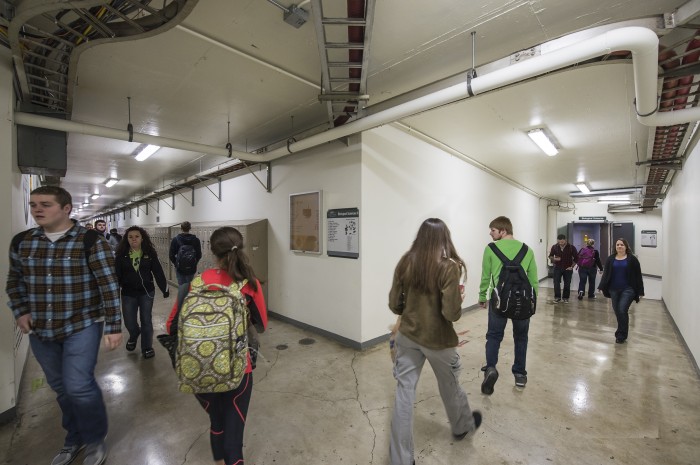
Nearly two miles of tunnels (10,436 feet) snake their way beneath Wright State’s Dayton campus linking 20 of 22 buildings in the academic section of campus.
The cold months of winter can make trudging to class a challenge. The snow blinds, the wind whips and the ice injures.
Because of these unforgiving elements, many prospective students, staff and faculty are drawn to Wright State because of its tunnel system, a convenient network of underground hallways and passages that act as a refuge from the harsh conditions above. Every day, thousands of people pour into the depths of Wright State, navigating their ways through the tunnels to their next class or meeting.
Yet, numerous misconceptions and urban legends about the origins of the tunnels have worked their way through the grapevine.
“I’m tempted to say the tunnels were built for weather purposes,” said Jacob Nolin, a sophomore English major. “But I know that Wright-Patterson Air Force Base is nearby, so they probably built the tunnels as a separate military facility.”
“This is what I’ve been told, and I believe it to be true: the tunnels are here for protection,” said Lauren Drislane, senior education major. “We’re so close to the base, and if anything bad were to happen, we would need to go underground for shelter.”
The Wright State tunnel system is believed to be one of the most extensive collegiate pedestrian tunnel systems in the United States. Nearly two miles of tunnels (10,436 feet) snake their way beneath Wright State’s Dayton campus linking 20 of 22 buildings in the academic section of campus.
According to Chris Wydman, archivist and records manager at Wright State, tall tales and rumors about the tunnels aren’t all that surprising.
“There are some nuggets of truth in some of these stories, but mostly they’re all pretty outlandish,” he said. “The main misconceptions are that the pedestrian tunnels were part of the original vision for campus or that they were designed to serve a dual purpose with WPAFB as a bomb shelter.”
Wydman has even heard crazy stories about there being laboratories in the tunnels where the government is doing top secret military experiments.
“Maybe E.T. is down there somewhere,” he joked.
To find the truth about the mystery of the tunnels, one has to peer into the past, around the time when Wright State’s first buildings were erected.
When Allyn Hall, Wright State’s first building, was built in 1964, campus was basically nonexistent — “in the boonies and off the grid,” as Wydman said. Then in 1966, when Oelman Hall was built, the electrical infrastructures of the two buildings needed to be connected. This was done through a simple underground maintenance tunnel.
“According to early faculty members,” said Wydman, “once Oelman was completed, faculty members and students began to sneak down to the tunnel during the winter months to travel between buildings without having to go outside.”
It is uncertain when the decision was made to officially use the tunnels for pedestrian traffic. Documents from the early planning stages indicate that the next phase of campus construction (for Fawcett and Millett Halls) would include basements and hallways that connected each building.
Wydman has also found in Special Collections and Archives the correspondence and meeting notes from that time period discussing the benefits for logistical purposes of having a tunnel system for the “consolidation of utilities, servicing and delivery into a set of well-defined corridors,” as well as for “weather-free pedestrian movement.”
Once the 1970s rolled around, Wright State’s founders realized just how valuable a tunnel system could be for the university’s future physical organization. The idea of a passageway that connects most buildings on campus “fit with the urban-centered university concept” that was originally envisioned for Wright State.
“The tunnels would essentially provide the university with a consolidated campus core with a minimal physical imprint on the surrounding land,” said Wydman.
Moreover, the founders considered the added levels of handicap accessibility the tunnel system would provide. As the tunnels began to expand concurrently with Wright State’s development, so did the disability services program.
Now, Wright State is recognized nationally as one of the most accessible and disability-friendly universities. According to www.disabilityfriendlycolleges.com, out of 2,500 four-year colleges in the US, only five provide academic and personal services comprehensive enough for a student with serious physical disabilities to live on campus — and Wright State is one of them.
“I don’t think anyone could have possibly imagined the ways in which the tunnel system would transform the campus and that it would become one of Wright State’s most distinctive features,” said Wydman.




 Milling around
Milling around  Wright State recognizes Nursing Professor Kim Ringo for advancing international student success
Wright State recognizes Nursing Professor Kim Ringo for advancing international student success  Wright State honors graduating students for distinguished doctoral dissertations
Wright State honors graduating students for distinguished doctoral dissertations  Top 10 Newsroom videos of 2025
Top 10 Newsroom videos of 2025  Museum-quality replica of historic Hawthorn Hill donated to Wright State
Museum-quality replica of historic Hawthorn Hill donated to Wright State 